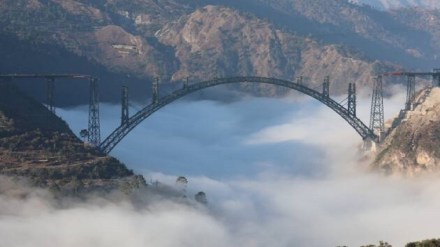The Chenab Rail Bridge, also known as the Chenab Arch Bridge, is being built over the Chenab River and once completed, it will be the highest railway bridge in the world, with a height of around 359 metres above the riverbed. The bridge is being built as part of the Udhampur-Srinagar-Baramulla rail link project, which will connect the Kashmir Valley to the rest of India by rail. The construction of the bridge has been a challenging engineering project due to the difficult terrain and harsh weather conditions in the region.
The bridge is being constructed using advanced technology and engineering methods, including the use of high-strength steel and cable-stayed arch design, to ensure its stability and strength.
How will it provide all-weather connectivity?
The Chenab Rail Bridge and the Udhampur-Srinagar-Baramulla rail link project are expected to have a transformative effect on the region, improving connectivity, boosting economic growth and development, and enhancing the quality of life for the people of Kashmir.
The bridge is an important part of the rail link project, which will provide all-weather connectivity to the Kashmir Valley by rail. Currently, the only way to reach the valley is by road or air, which can be difficult and expensive, particularly during the winter months when the roads are often blocked due to snowfall.
Once completed, the rail link will connect the Kashmir Valley to the rest of India, allowing people and goods to travel to and from the valley throughout the year, regardless of weather conditions. The Chenab Rail Bridge, which is the highest railway bridge in the world, is a key component of this project, as it will provide a safe and reliable means of crossing the Chenab River, which is prone to flash floods and landslides.
Boosting tourism in the Valley
In addition to providing all-weather connectivity to the Kashmir Valley, the rail link is expected to have a significant impact on the region’s economy and tourism industry. It will provide a faster and more efficient means of transporting goods and people, which will help to boost economic growth and development in the region. It will also make it easier for tourists to visit the valley, which is known for its natural beauty, cultural heritage, and religious significance.
